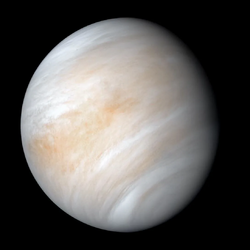Venus: Difference between revisions
(Created page with "{{Infobox planet |name = Venus |native name = |image = Venus.png |alt = |caption = |system = Sol, II |moons = |satellites = |diameter = 12,104 km |day_length = 243.025 earth days (retrograde) |year_length = 224.701 earth days |gravity = 0.904 g |atmosphere = |temperature = 464 °C (867 °F) |adjective = Venusian |population = 1,773,000 |government = {{flag|N...") |
mNo edit summary |
||
| (One intermediate revision by the same user not shown) | |||
| Line 16: | Line 16: | ||
|adjective = Venusian | |adjective = Venusian | ||
|population = 1,773,000 | |population = 1,773,000 | ||
|government = {{flag|North Atlantic Conglomerate}} {{small|([[Venusian Union]]}}<br> | |government = {{flag|North Atlantic Conglomerate}} {{small|([[Venusian Union]])}}<br> | ||
[[Republic of Celestia]]<br> | [[Republic of Celestia]]<br> | ||
[[Dodecanese Federation]]<br> | [[Dodecanese Federation]]<br> | ||
| Line 29: | Line 29: | ||
===Chemical composition=== | ===Chemical composition=== | ||
===Internal structure=== | ===Internal structure=== | ||
===Surface=== | ===Surface=== | ||
===Gravitational field=== | ===Gravitational field=== | ||
Latest revision as of 20:06, 7 April 2024
| Venus | |
|---|---|
 | |
| Star, Position | Sol, II |
| Diameter | 12,104 km |
| Length of day | 243.025 earth days (retrograde) |
| Length of year | 224.701 earth days |
| Surface gravity | 0.904 g |
| Mean temperature | 464 °C (867 °F) |
| Adjective | Venusian |
| Population | 1,773,000 |
| Government | Republic of Celestia |
Venus is the second planet from Sol. It is notable for having an extremely dense atmosphere, composed mostly of carbon dioxide with a thick, global sulfuric acid cloud cover. At the surface it has a mean temperature of 737 K (464 °C; 867 °F) and a pressure of 92 times that of Earth's at sea level. It was first settled in 2077 by the crew of the HAVOC 2 mission, after the catastrophic failure of the HAVOC 1 mission in 2062 which killed all 30 of its crew members. It is now home to nearly 2 million inhabitants, living in floating cities high in Venus' atmosphere where the pressure and temperatures are similar to that of Earth's surface.